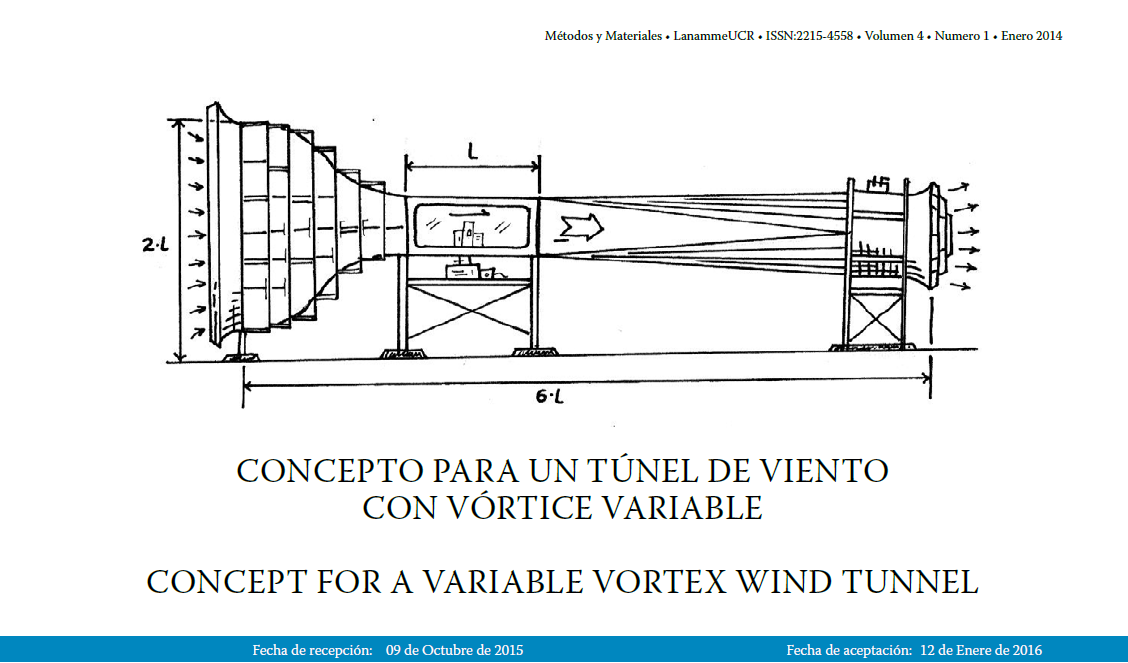Resumen
Se propone un diseño de bajo costo de un túnel de viento con vórtice variable, que mediante la inyección controlada de flujos cruzados direccionales, permite variar el tamaño y velocidad de rotación de los vórtices independientemente de la velocidad promedio del flujo. Se evita con ello la reconfiguración de la sección de estabilización, comúnmente utilizado en los túneles de capa limite. El uso de este túnel de viento en la escala y velocidad indicada serían para pruebas prácticas usando modelos a escala para cuantificar la interacción del viento atmosférico con construcciones civiles, caracterizar patrones de erosión de terrenos y transporte de sedimentos, y determinar los patrones generales de dispersión de contaminantes atmosféricos en ciertas escalas de terreno; podría utilizarse también para definir parámetros de calibración en modelos numéricos de flujo de fluidos a baja velocidad en dos dimensiones.
Citas
Ahmad, K., Khare, M., & Chaudry, K. K. (2005, Setiembre). Wind tunnel simulation studies on dispersion at urban street canyons and intersections. Journal of Wind Engineering and Industrial Aerodynamics, 93 (9), 697-717.
American Society of Heating, Refrigerating and Air-Conditioning Engineers. (2010) Fundamentals. Atlanta: ASHRAE Press.
American Society of Heating, Refrigerating and Air-Conditioning Engineers. (2013) Systems and Applications. Atlanta: ASHRAE Press.
Anina, S., Rüdiger, H., & Stanko, B. (2015, Setiembre). Numerical simulations and experimental validations of force coefficients and flutter derivatives of a bridge deck. Journal of Wind Engineering and Industrial Aerodynamics, 144, 172-182.
Barlow, J. B., Rae, W. H. R., & Pope, A. (1999). Low-speed Wind Tunnel Testing (3a ed.). Nueva York: Wiley Interscience.
Bernstein, J. R., S. (1976, Marzo). Reduction of wind-tunnel wall interference by controlled wall flow. NASA Technical Report (CR-2654), 57 pp.12
Bianco, L., Wilczak, J., & White, A. (2008, Agosto). Convective boundary layer depth estimation from wind profilers: Statistical comparison between an automated algorithm and expert estimations. Journal of Atmospheric and Oceanic Technology, 25 (8), 1397-1413.
Colman-Lerner, J. (2011). Wind Tunnels and Experimental Fluid Dynamics Research. Rijeka: InTech.
Colegio Federado de Ingenieros y de Arquitectos de Costa Rica. (2010). Código sísmico de Costa Rica. San José: CFIA.
Eck, B. (1973). Fans: Design and Operation of Centrifugal, Axial-flow and Cross-flow Fans. Oxford: Pergamon Press.
Goodrich, M., & Gorham, J. (2008). Wind Tunnels of the Western Hemisphere. Washington, D.C.: Federal Research Division. Library of Congress.
Hangan, H. (2015, Agosto). Novel techniques in wind engineering. Conferencia inaugural del 14th International Conference on Wind Engineering. Ontario.
Hirsch, C. (2007). Numerical Computation of Internal and External Flows. Amsterdam: Butterworth-Heinemann.
Kingsbury, N. R. (1990). World directory of aerospace vehicle research and development. Washington, D.C.: GAO-USAF. (Documento interno disponible al público)
Knight, I. (2001, Enero). The design and construction of a vertical wind tunnel for the study of untethered firebrands in flight. Fire Technology, 37 (1), 87-100.
Kundu, P. K., Cohen, I. M., & Dowling, D. R. (2011). Fluid Mechanics (5a ed.). Amsterdam: Academic Press.
Mehta, R. D., & Bradshaw, P. (1979, Noviembre). Design rules for small low speed wind tunnels. The Aeronautical Journal of the Royal Aeronautical Society, 443-449.
Monge, J. G. (2010, Noviembre). Túnel de viento de capa límite. Ponencia presentada en el XXIX Minicongreso del Centro de Investigaciones Geofísicas. San José.
American Society of Civil Engineering, (2013). Minimum design loads for buildings and other structures (ASCE 7-10). Reston: ASCE.
Pegg, R. J. (1995). Low speed wind tunnel tests of two waverider configuration models. Sixth International Aerospace, Planes and Hypersonics Technologies Conference. (Descargado el 12 de diciembre de 2005 de http://larc.nasa.gov.com/resources/6APC/art.asp)
Pereira, J. (2013). Wind Tunnels: Aerodynamics, Models and Experiments. Nueva York: Nova Science Publichers, Inc.
Reinhold, T. (1982). Wind Tunnel Modeling for Civil Engineering Applications. Cambridge: Cambridge University Press.
Rivera, R. (2005). Diseño y construcción de un túnel de viento para la Facultad de Ingeniería. Tesis de grado para optar por el título de Licenciatura en Ingeniería Civil. San José: Universidad de Costa Rica.13
Roberts, S. (2012). Wind Wizard: Alan G. Davenport and the Art of Wind Engineering. Princeton: Princeton University Press.
Schlichting, H., & Gersten, K. (2000). Boundary-layer Theory (8a ed.). Berlin: Springer.
Shao, Y. (2008). Physics and Modelling of Wind Erosion (2a ed.). Berlin: Springer.
Shojaee, S., Uzol, O., & Kurç, C. (2014, Febrero). Atmospheric boundary layer simulation in a short wind tunnel. International Journal of Environmental Science and Technology, 11 (1), 59-68.






